*Copyright 1998 SAFE-CAPTURE INTERNATIONAL INC. Reprinted with permission from Safe-Capture International, Inc. and the Safe-Capture International Foundation, Mt. Horeb, WI, USA. All rights reserved.
Abstract
Introduction
The success and growth of any discipline is dependent upon communication and interaction between primary researchers and those performing field applications. If communication or information exchange is inefficient, poor techniques are repeated, and growth is slow. If information is readily accessible and exchanged freely, techniques are refined rapidly, and rapid improvement ensues.
While expertise on restraint, immobilization, anesthetic, and analgesic techniques exists for many species, access is limited in our current system of information dissemination. Currently, research on these topics is published in a multitude of periodicals and references, many of which are foreign or specialty journals with limited circulation. Lag time between development of new techniques and publication also occurs. Other techniques are disseminated by personal communication only, without ever being published. Lastly, techniques which are associated with mortality and/or morbidity may never be reported or published.
Additionally, much of the available information is incomplete. Many references provide only dosage information, while information concerning drug concentration, time parameters (induction, working restraint time, recovery time), confinement, and emotional status of the animal are not included. These parameters are often required to determine applicability of the technique, and to assist in making rational anesthetic decisions.
Anyone working with exotic species can attest to the often urgent need for anesthetic information, while locating a source, acquiring original research material, and extracting the needed data can be difficult and time consuming.
Thus, there is a need for a central information source of readily accessible bibliographic information, and rapid access to reliable, detailed species-specific anesthetic, immobilization, capture, and analgesic information. The Animal Capture and Anesthesia Database (ACAD 1.0) meets this need.
Objective
The purpose of the ACAD is to expand access to validated anesthetic techniques, and to encourage better data collection and sharing of information among professionals, by organizing and assembling a comprehensive, peer reviewed, central computerized database for animal capture, immobilization, and anesthetic techniques. This database would be readily accessible electronically, affording quick access to pertinent information necessary to make informed choices for anesthetic regimens.
What is the structure of ACAD?
The ACAD is a collection of data records in a computerized relational database. Records consist of synopses of anesthetic/analgesic research, and procedures collected from a variety of sources including peer reviewed references, textbooks, meeting proceedings, and personal communication of field techniques from primary researchers.
How does ACAD function?
Step 1: The Opening Screen Lists All Data Records in Alphabetical Order by Species
Figure 1
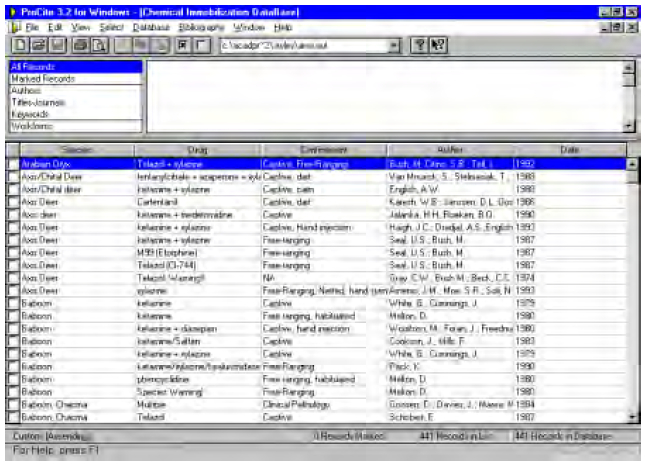
Step 2: Records Can Be Sorted by Selecting Retrieval Topics or Keywords
Retrieval topics/keywords include: Species (deer, elk, tigers, etc.), family (cervids, canids, camelids, etc.), drug used (ketamine, carfentanil, xylazine, Telazol etc.), warnings (complications reported with the use of techniques or medications in various species, documented drug interactions, or studies which documented the LD 50), pre-anesthetic considerations, pathology (drugs used in sick and debilitated animals which afforded survival), clinical pathology (anesthetic effects on clinical pathology results), reproduction (effects in pregnant animals, or during obstetric procedures), oral medications, author, and title.
By selecting a keyword, data records associated with the keyword are retrieved and listed. These records are defined for “quick scan” by the species, drug used, confinement, author, and date. In this example, the keyword “cervids” is selected, and all “cervids” linked records are displayed.
Figure 2
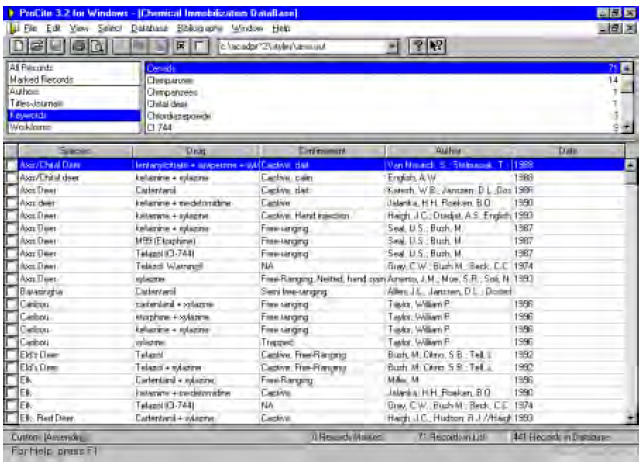
Step 3. View a Specific Data Record
To view a specific data record, double mouse click on the selection. This opens the complete data record which contains the following information:
1. Source of information (journal, book, proceedings, or personal communication)
2. Species
3. Scientific name
4. Drug used including dosage and concentration
5. Induction time (time from medication injection to loss of head lifting response when mechanically stimulated)1
6. Antagonist (if used) including dosage and concentration
7. Total restraint time (time from loss of head lifting response to regaining head lifting response.)1
8. Total time to recovery (time from loss of head lifting response to standing)1
9. Type of confinement the animal was in, degree of restraint prior to anesthesia, and method of drug delivery
10. Number of animals in the study
11. Mortality rate
12. Any pertinent comments about the procedure
13. Warnings
14. Keywords (all keywords by which the record can be retrieved)
(Dosages peer determined to be “preferred dosages” are indicated by double asterisk**)
In the example below, we double mouse clicked and opened this complete data record on black bear.
Figure 3
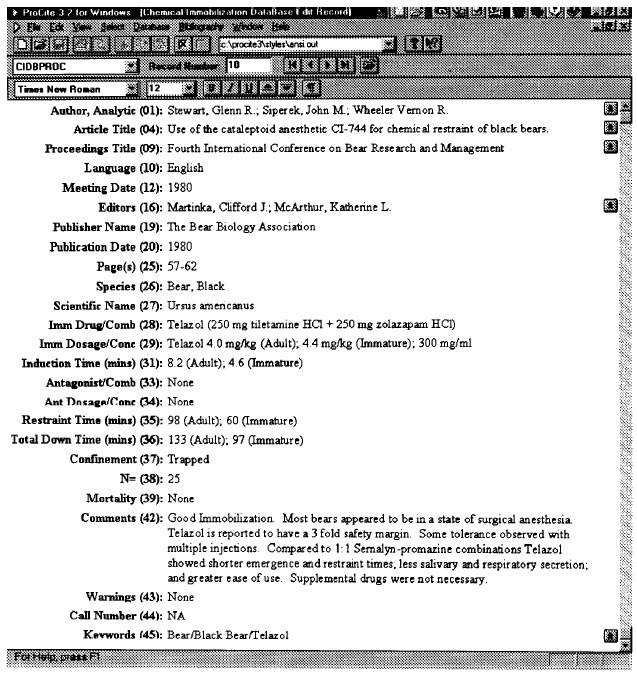
What other information is readily accessible via the ACAD?
Techniques associated with mortality or morbidity are scattered and difficult to find in the literature. ACAD organizes this information and provides rapid access to species, drug, and drug interaction warnings. Pre-anesthetic considerations, regimens found safe in debilitated animals, and the effects of anesthetics on clinical pathology results and reproduction are also easily retrievable.
Figure 4
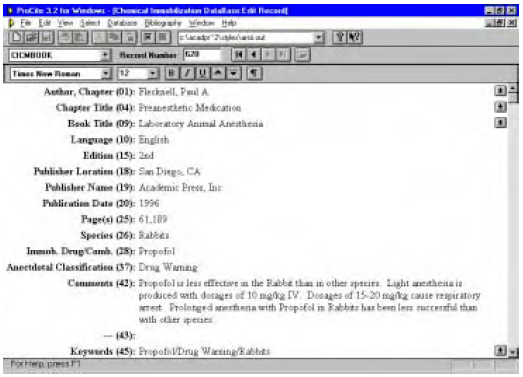
Figure 5
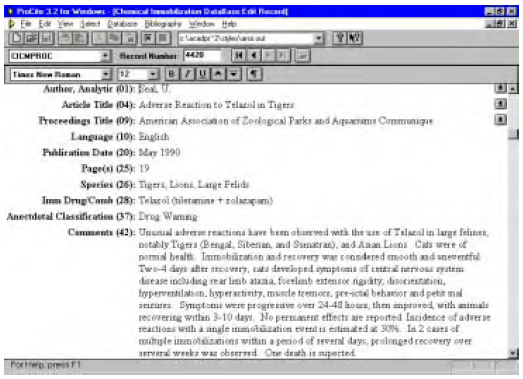
How do you obtain access to the Animal Capture and Anesthesia Database?
Access will be by Internet, hard copy, and distribution of periodically updated discs.
Conclusions
The Animal Capture and Anesthesia Database (ACAD 1.0):
- Centralizes rapid access to validated, peer reviewed, detailed species specific anesthetic, immobilization, capture, and analgesic information.
- Allows comprehensive species and topic bibliographies to be readily obtained.
- Alerts and warns of anesthetic related mortality or morbidity, and the effects of anesthetic procedures on clinical pathology results or reproduction.
- Encourages better data collection and sharing of information among professionals.
- Enhances the ability to make informed choices on anesthetic regimens in captive and free-ranging species.
Acknowledgments
This work was supported by Safe-Capture International, Inc. and the Safe-Capture International Foundation—promoting animal welfare by collecting, organizing, and disseminating information on anesthetic regimens and techniques useful in the handling of free ranging and captive species.
Literature Cited
1. Stewart G, J Siperak, V Wheeler. 1980. Use of the cataleptoid anesthetic CI-744 for chemical restraint of black bears. Bears—Their Biology and Management Papers of the Fourth International Conference on Bear Research and Management. The Bear Biology Association, Pp. 57–61.
2. Seal U. 1990. Adverse reaction to Telazol in tigers. American Association of Zoological Parks and Aquariums Communique. May. Pp. 19.
3. Flecknell P. 1996. Preanesthetic medication. In: Laboratory Animal Anesthesia. Academic Press, Inc., San Diego, CA, Pp. 61, 189.